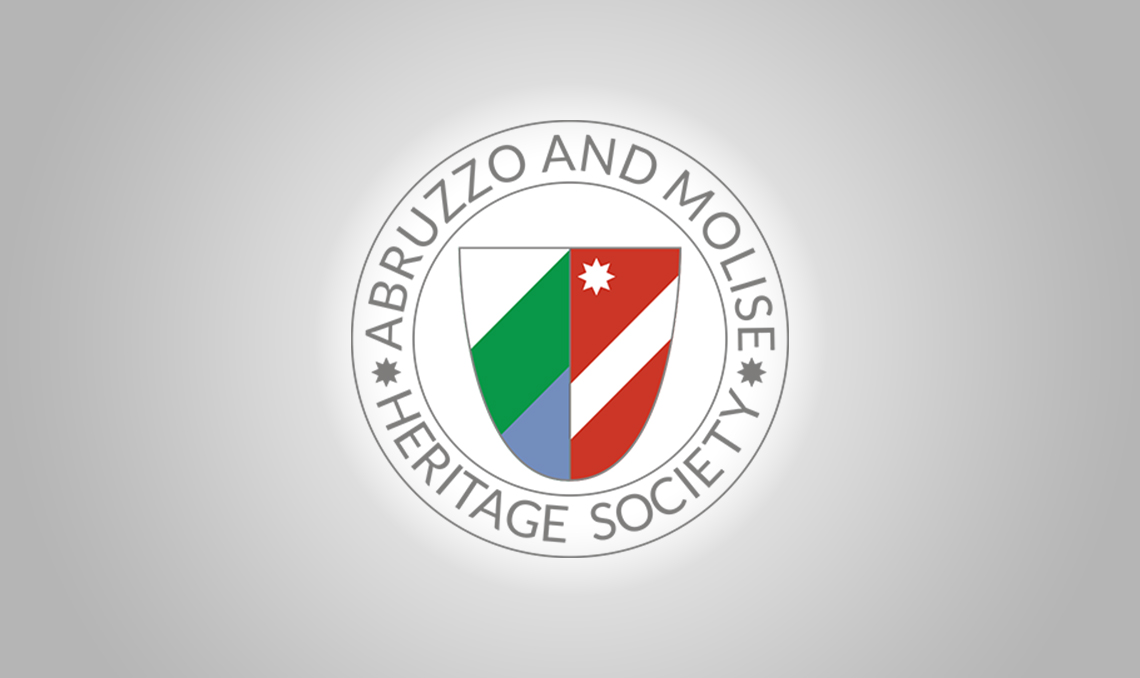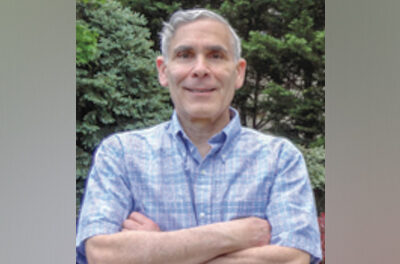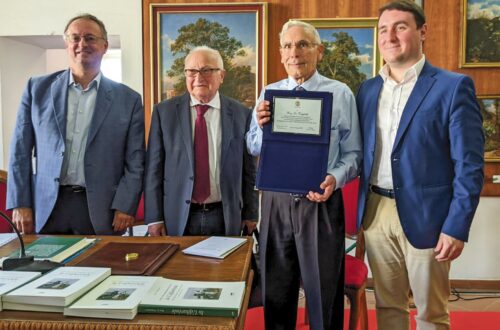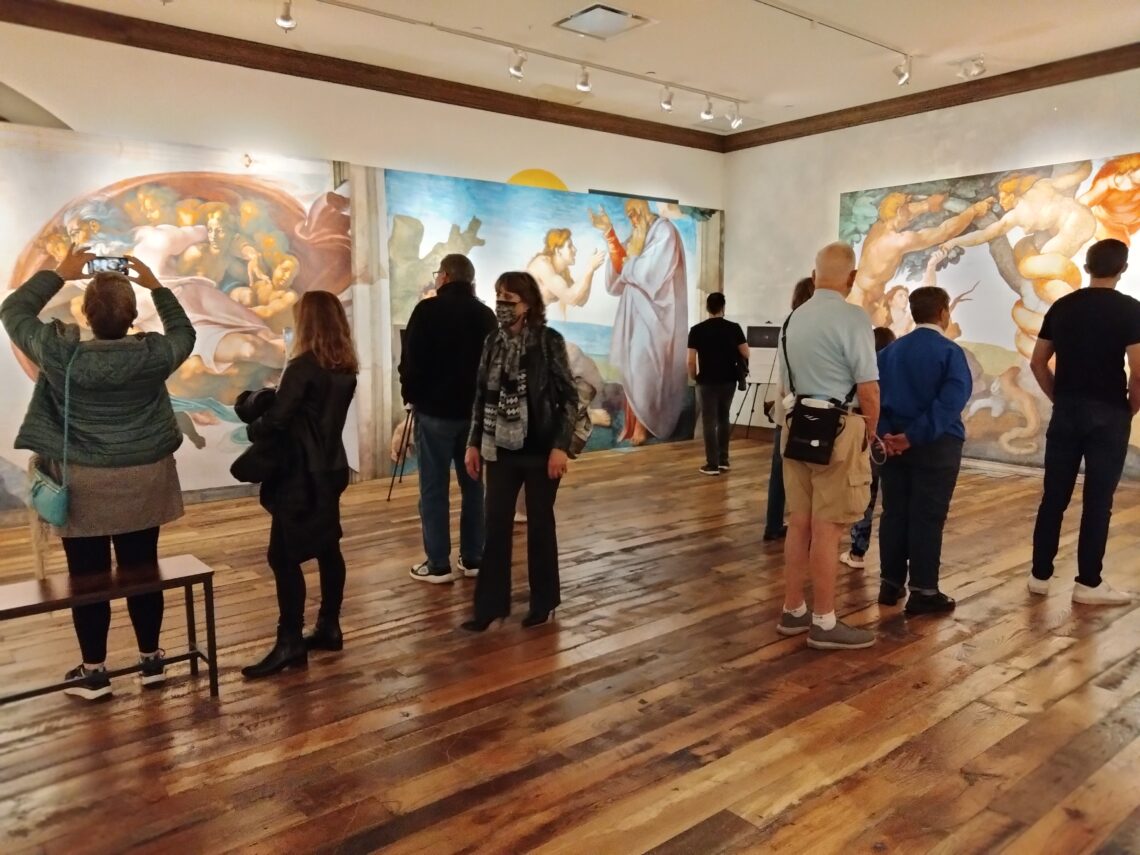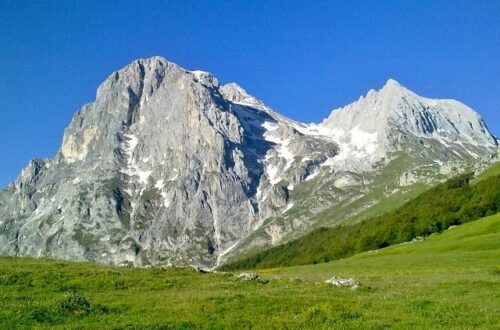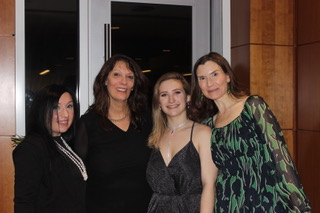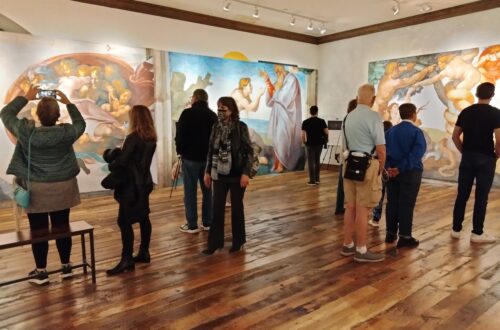-
Postal Curator Daniel Piazza to Discuss Historical Period of Italian Philately
On Sunday, July 31, 2022, at 7 p.m., renowned stamp expert Daniel A. Piazza will give a virtual talk to AMHS members on a historical period of Italian stamps. His topic will be “The ‘Fascist Style’ in Italian Philately, 1922-1941.”
Piazza has been the Chief Curator of the Smithsonian’s National Postal Museum since 2014. He is responsible for exhibitions, acquisitions and research related to the museum’s collection of 6 million postage stamps and postal artifacts comprising one of the largest such collections in the world. His exhibitions have included “Freedom Just Around the Corner: Black America from Civil War to Civil Rights,” which won the 2016 Smithsonian Research Prize.
Details on the Zoom link will follow closer to the date of the talk.
.
July/August 2022
-
In Full Swing
AMHS Pushes On With Activities in Late Winter and Early Spring
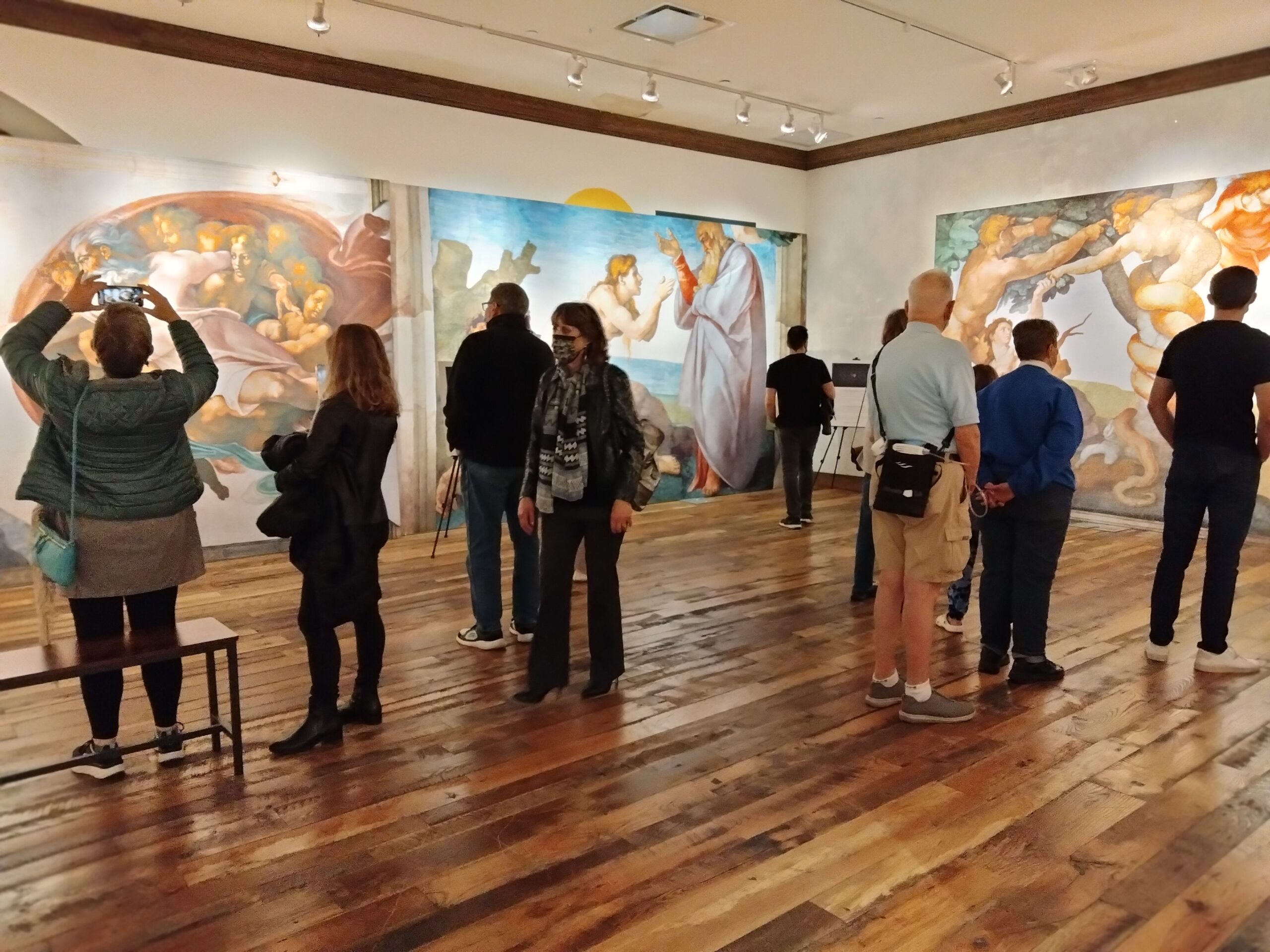
AMHS members enjoy the artist’s perspective on the art of the Sistine Chapel. Historian Leads Discussion of History of Italians in Louisiana
By Nancy DeSanti, 1st VP-Programs
In one of our series of online events, AMHS members on February 27, 2022, participated in a very informative virtual talk by historian and author Alan Gauthreaux on his book, “Italians in Louisiana: History, Heritage and Tradition.”
In introducing the speaker, AMHS Vice President Lynn Sorbara mentioned that the story of Italians in New Orleans has personal meaning for her, as the maternal side of her family settled in New Orleans from their home in Sicily. Lynn noted that our speaker had a varied background—as a high school and college teacher and in law enforcement as a correctional officer. He did a great deal of research, and the basis of his book began as his master’s thesis.
Gauthreaux asked: What does a historian with a French name know about Italians in Louisiana? And he answered his own question by saying the subject is of interest to anyone growing up in Louisiana, adding that he “gained weight” doing his research interviewing Italian families which included sharing meals.
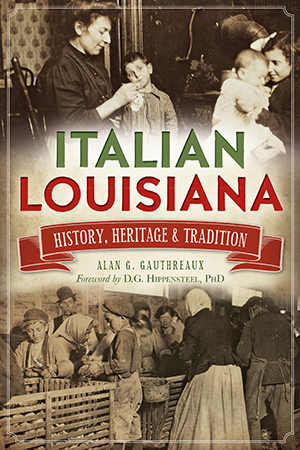
The history of Italians in Louisiana was the subject of Alan Gauthreaux’s captivating online presentation. He noted that he used the words Italian and Sicilian interchangeably, while noting that many of the immigrants to Louisiana came from Sicily, or parts of Southern Italy. Taxation, poor soil conditions and plant disease were among the reasons that they came. Italians, who were known for working in a hot, humid climate, were invited to come after the Civil War due to the perceived shortage of labor after the abolition of slavery. The waves of immigration were greatest during the period 1900-1910.
Gauthreaux noted that Italians did not hold the same prejudices as the native Caucasians and generally had good relationships with African Americans. This did not always sit well with the white Louisianans.
He told us the fascinating story about David Hennessy, the New Orleans police chief who was assassinated in 1890. He notes that the saga was the subject of a 1992 HBO movie, “Vendetta.” Gauthreaux said research shows that Hennessy was “one of the dirtiest cops in Louisiana history,” and the real story was about mafia clans and the elites of New Orleans that were fighting over control of the docks—a lucrative business. As a result, a number of Italians were rounded up; a trial was held, and even after their acquittals, they were not released from custody but were sent back to the jail, which Gauthreaux said “was probably a set-up.” A mob of 10,000 formed, stormed the jail, and the sheriff’s deputies let some of the crowd members in.
The mob lynched 11 Italian prisoners, in what is the largest mass lynching in American history. They were hung from trees, dressed in their Sunday best. This shocking event almost led to a war between Italy and the United States, which Gauthreaux said Italy likely would have won due to its superior navy. In the end, $25,000 was paid to the families of the victims. In 2019, New Orleans Mayor LaToya Cantrell formally apologized and announced plans for a monument near the old jail.
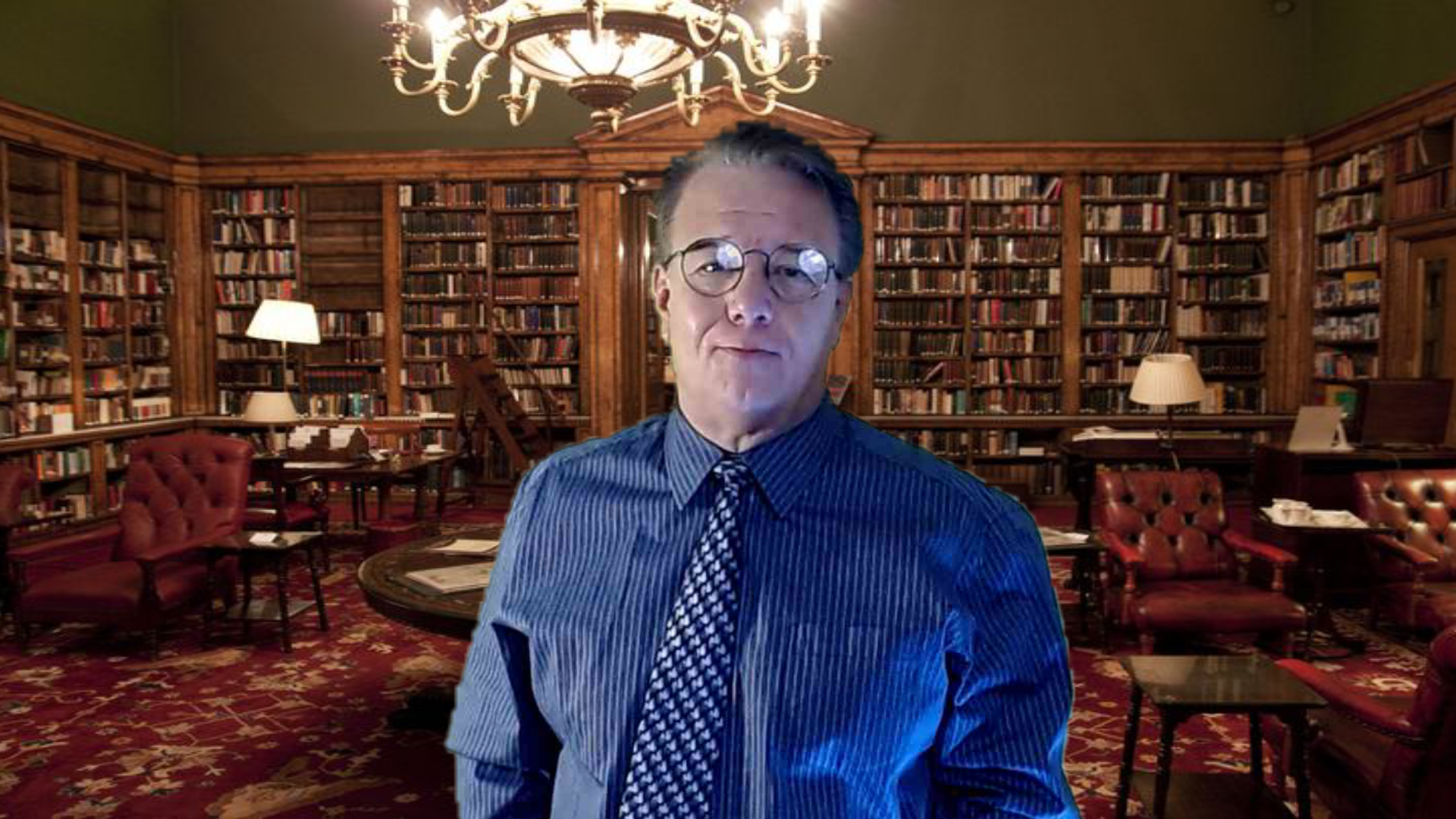
Author and historian Alan Gauthreaux
Credit: touchpointpress.comIn those days, Gauthreaux noted, “extra-legal justice” happened frequently in the South and law enforcement was likely “in on it.” The powers-that-be went after Italians they didn’t like and got away with it. For example, in another parish, six Italians were executed for a single murder in 1921, and three Italians were lynched near New Orleans in Tallulah in 1899, in a dispute over a goat
Finally, in 1936, Robert Mestri became the first Italian mayor of New Orleans. As Italians assimilated, one became a state supreme court justice; another was the famous singer Louie Prima. And Nick LaRocca was the first person to record a jazz number. Lynn mentioned that she is related to Nick LaRocca on her mother’s side. She added that her great uncles in Louisiana had a strawberry farm that was very successful, so in thanksgiving to their good fortune, they built a chapel on their property. She said the Ku Klux Klan burned it down, and after the chapel was rebuilt, burned it down again. Her great uncles had a sit-down with the Klan in their barn, which suffice it to say, did not end well for the Klan members and her relatives were not bothered again.
There was a lively discussion of the prejudices experienced not only by the Italians but also other ethnic groups, including Eastern European, Jewish and Native American.
Gauthreaux’s book “Italians in Louisiana: History, Heritage and Tradition.” Is available on Amazon, as is his other book, “Dark Bayou” on famous Louisiana homicides.
Many thanks to Lynn for arranging the talk and to our speaker Alan Gauthraux for a fascinating and informative discussion.
Carla Gambescia Tests Audience’s Knowledge of Italian Culture
By Nancy DeSanti, 1st VP-Programs
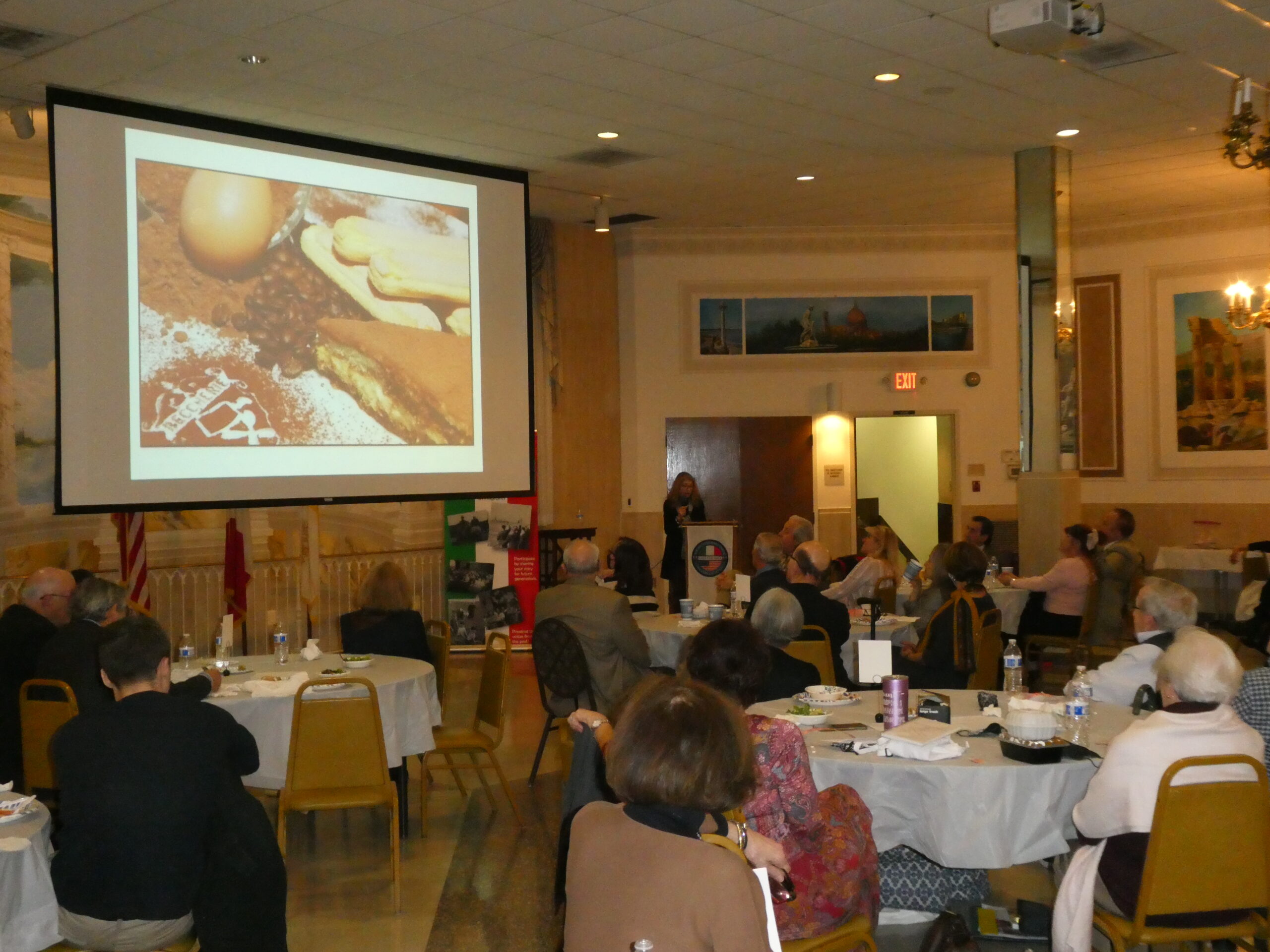
AMHS members hear about Italy A to Z from Carla Gambescia. Our first AMHS in-person luncheon program of the year was a very successful event that drew 80 people to hear Carla Gambescia, an expert on Italian culture who gave an interesting talk involving audience participation. The event was held at Casa Italiana on March 27, 2022, and it was co-sponsored by the Casa Italiana Sociocultural Center and the Casa Italiana Language School.
Carla gave us a trivia quiz to test our knowledge. She said not to worry — if we got 5 right out of 10, she said we were doing well. And the program was a good opportunity to discover new fun facts and intriguing insights.
Carla is the author of “La Dolce Vita University: An Unconventional Guide to Italian Culture from A to Z,” which is a light-hearted series of mini-essays on everything from Arlecchino to Zanni. You will be able to find the answers to the trivia questions in Carla’s book, which is available on Amazon.com.
She was an engaging speaker, and along the way, we learned all kinds of fun facts, such as that Caterina de Medici, after marrying a French prince and later becoming Queen of France, introduced the French not only to the fork, to the use of herbs, and to broccoli, peas and artichokes, but also to high heels (How cool is that?).
Our knowledge was tested by Carla’s questions and the audience was asked to raise their hand to show their answer as she went through her PowerPoint presentation. Among the questions were:
Which was both prohibited by the Church and condemned by Venice? (a) bocce (b) perfume (c) coffee (d) Casanova’s memoirs.
Which group of Venetians were not permitted to leave the Venetian lagoon on penalty of death? (a) shipbuilders (b) doctors during times of plague (c) glass blowers (d) those whose name were in the Golden Book.
Before “Bologna” became a famous sauce, did it refer to (a) a noble breed of dog (b) a Renaissance hat style (c) an intricate style of wood carving (d) a military medieval maneuver.
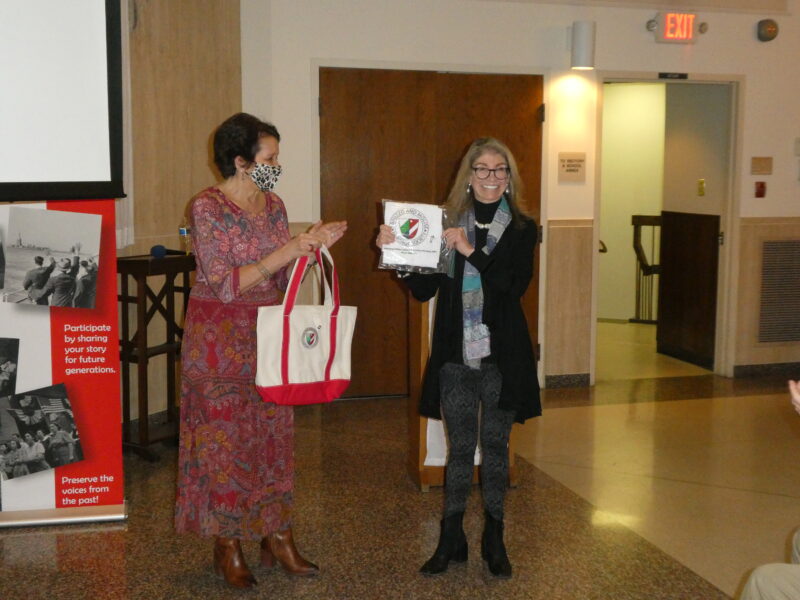
Carla Gambescia (right) receives thank you gifts from Maria D’Andrea-Yothers Credit: Sam Yothers Carla, who lives in Chappaqua outside New York City, owned an Italian restaurant which she ran for 13 years. She also had a successful career in marketing and advertising, which she said made her especially interested in Italy’s “Third Golden Age” — after the Roman Empire and the Renaissance — namely, how post-war Italy morphed from the face of Il Duce to the face of La Dolce Vita and conquered the world through passion and excellence in the realms of film, fashion and design, food and wine.
Her family’s roots are in Sulmona in Abruzzo, and also Basilicata, and she traces her love for all things Italian to her parents. Her mother loved the Italian Renaissance Masters and her father introduced her to Dante when she was 8 years old. She said her love of Italy grew when 25 years ago, she went on a bicycle trip in Sicily, where she said, “Something magical happened — I rediscovered my roots and I fell deeply in love with the land of my ancestors.” That experience led her to take dozens of trips all over Italy. Being very adventurous, she has hiked or biked in all 20 regions of Italy. Carla said her next trip to Italy will be a walking tour from Lucca to Rome.
After giving her talk and meeting some of our members, Carla said she feels part of the “Casa Italiana famiglia.” We hope she will visit us again.
We would like to thank Maria D’Andrea-Yothers for arranging for the lunch from A Modo Mio, all those who helped serve the lunch, and all those who donated raffle prizes and bought tickets.
Members Take ‘Field Trip’ to Sistine Chapel Exhibit, Share Meal
By Carmine James Spellane
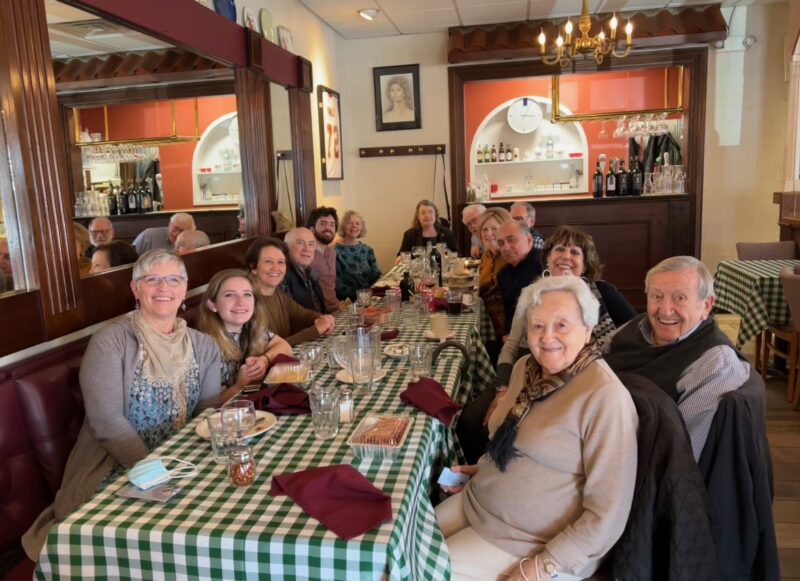
AMHS members enjoy lunch at the Italian Oven in Virginia. On April 2, some 20 AMHS members ventured to Tyson’s Corner Center in Virginia to see a special exhibit “Michelangelo’s Sistine Chapel.” This unique exhibit used modern technology to allow the visitor to see the art of the Sistine Chapel from the close-up perspective of its creator, Michelangelo.
The excursion was organized by AMHS Board Member Chris Renneker who facilitated the purchase of a group discount rate for tickets. Visitors described the exhibit as “magnificent, moving and informative.”
Following their virtual visit to one of the world’s great masterpieces, the group met for lunch at the Italian Oven in McLean for a shared meal and conviviality. After a cold Covid winter, the outing was a tonic for all who participated. The Society will explore holding more such events in the near future.
May/June 2022
-
AMHS Membership
By Lynn Sorbara, 2nd Vice President-Membership
New Members We warmly welcome the following new members: Stephen D’Alessio, Donna M. DeBlasio, William DiGiovanni, Marco Dorsett, Marcella Finelli, Erika Pontarelli, Mary Ann Re, Janice Troilo, and Aubrey White. Birthdays Compleanni a Maggio
Joseph Scafetta, Jr., May 10; Amy Antonelli, May 15; Kathlyn Nudi, May 16; Marcella Finelli, May 17; Robert Woolley, May 19; Peter Bell, May 20; Rocco Del Monaco, Giulia Michonski and Abby Cuviello, May 21; Aldo D’Ottavio and Cora Williams, May 22; Cristina Scalzitti, Jill Werhane and John Dunkle, May 25; Ennio DiTullio and Richard Leiobold, May 29; and Renato Orcino, May 30Compleanni a Giugno
Judy Maimone D’Ambrosi, June 2; Rev. Frank Donio, June 3; Joseph Lupo and Jo-Ann Pilardi, June 9; Alberto Paolantonio and Robert Tobias, June 10; Ruth Bergman, June 14; Harry Piccariello and Joan Galles, June 24; Margaret Uglow, June 25; Omero Sabatini, June 26; Barbara Bernero and Rita Orcino, June 28; and Helen Antonelli Free, Laura Gentile and Jason Quaglia, June 30.Anniversaries Anniversari a Maggio
Francesco & Anna Isgro, May 19; and Mario & Carmen Ciccone, May 27. Ordination of Rev. John V. DiBacco Jr., May 13.Anniversari a Giugno
Joseph & Betsy Ruzzi, June 4; Omero & Belinda Sabatini, June 6; Tony & Judy D’Ambrosi, June 22; Anthony & Elodia D’Onofrio, June 25; Lucio & Edvige D’Andrea, June 27; and Roger & Joan Galles, June 30.Membership Information Category # of Persons
Associate (Couple) 4 X 2 = 8
Associate (Individual) = 42
General (Couple) 49 X 2 = 98
General (Individual) = 92
Honorary = 11
Scholarship = 2
Student = 8
Total = 261May/June 2022
-
May 15th Program to Feature Panel of Italian Food Experts and Chefs
By Nancy DeSanti, 1st Vice President-Programs

Author, chef and TV personality Amy Riolo will lead a distinguished panel of experts on May 15.
Credit: metrocookingdc.comWe invite you to join us for a unique opportunity to explore the world of pasta through the eyes of renowned Italian chefs and culinary experts. Our second luncheon program of the year will be held at Casa Italiana on May 15, 2022, at 1 p.m.
The event is entitled “For the Love of Pasta: Preserving Italian Cuisine, Culture and Health.” It is being co-sponsored by the Casa Italiana Sociocultural Center and the Casa Italiana Language School.
Organized and moderated by award-winning author/chef Amy Riolo, a panel of five food experts and chefs will share the fascinating ways in which they are passing down not only recipes, but Italian culture, nutrition and values to their patrons, clients, and future generations. You will learn the essence of Italian hospitality, get to the core of how pasta fits into the Mediterranean lifestyle, learn tricks of the trade when making your own pasta at home and where to find it in the Washington, D.C. area.
Moderator: Amy Riolo, award-winning, best-selling author of 11 books, and chef who has taught cooking classes at Casa Italiana. She is also a food historian and a Mediterranean Diet specialist.
Panelists:
- Luigi Diotaiuti, owner of award-winning restaurant Al Tiramisu, who was named Ambassador of Basilicata Cuisine in the World by the Federation of Italian Cooks
- Stefano Ferrari, owner of Italian gourmet retail store LIFeSTYLE and co-founder of Italian import company Cibo Divino
- Francesco Marra, CEO of Pizza University and Culinary Arts Center and Oro Catering which runs the café in the Embassy of Italy
- Matteo Venini, a native of Lake Como who is executive chef and co-owner of Stellina Pizzerias
- Diane Welland, director of nutrition communications for the National Pasta Association, who gave a talk to AMHS in April 2018
Before the program begins, we will have a delicious lunch catered by Fontina Grille. Space is limited, and registration closes on May 12 at 5:00pm, so if you are interested in attending, please register at:
May/June 2022
-
Boxing Great Rocky Marciano Had Abruzzo Roots
By Joseph “Sonny” Scafetta, Jr.

Rocky Marciano in his prime.
Credit: WikipediaRocco Francis Marchegiano was born in Brockton, Massachusetts, on September 1, 1923. He was named after his paternal grandfather. Rocco’s father, Pierino, had emigrated in 1912 from the town of Ripa Teatina (population 4,050 in the 2018 Census) in the province of Chieti in the region of Abruzzo. His mother, Pasqualina Picciuto, had emigrated from the town of San Bartolomeo in Galdo (population 4,884 in the 2015 Census) in the province of Benevento in the region of Campania. Rocco was the oldest of six children.
As a boy, Rocco worked out on homemade weight lifting equipment and used a stuffed mail bag hung from a tree branch in his back yard as a heavy punching bag. Rocco attended Brockton High School where he played baseball and football. He dropped out after tenth grade to work as a chute man on a delivery truck for an ice and coal firm. He later worked as a ditch digger, a railroad track layer, and a shoemaker.
In March 1943 at age 19, he was drafted into the U.S. Army. After boot camp, he was transferred to Swansea, Wales, where he helped to ferry supplies across the English Channel to Normandy. While awaiting discharge, he represented the Army and won the 1946 Amateur Armed Forces Boxing Tournament. He was honorably discharged at Fort Lewis, Washington, in March 1946. In March 1947, he tried out for a farm team of the Chicago Cubs in Fayetteville, North Carolina, but did not make the roster. He then returned to Brockton where he began to train as a boxer with Allie Colombo. Rocco was five feet, 10½ inches tall, and was a heavyweight. His handler suggested that he shorten his full name to Rocky Mack, but Rocco rejected the surname in favor of the Italian Marciano. During the Spring of 1948, he competed in the Olympic tryouts held in the Boston Garden. Although he knocked out his first opponent, Rocky hurt his hands during the bout and was forced to withdraw.
Rocky began fighting as a pro on July 12, 1948. He won his first 16 bouts by knockouts, all before the 5th round, including nine in the 1st round. In his 17th fight, Rocky went the distance and defeated Don Mogard (17-9-1) in a scheduled ten-rounder for his first unanimous decision. Rocky won his next three fights by knockouts. He won his 21st fight by his second unanimous decision over Ted Lowry (58-48-9). After four more knockouts, Rocky won his only split decision against undefeated Roland La Starza (37-0-0).
The 27-year-old Rocky then took a break to marry 22-year-old Barbara Cousins in 1950. They had two children, Mary Anne (1952-2011) and Rocco Kevin. After returning to the ring, Rocky scored three more knockouts before his 30th bout which he won by a third unanimous decision in a rematch against Lowry who was then (61-56-10). Four more knockouts were followed by his 35th fight which was his fourth unanimous decision in a bout with Willis “Red” Applegate (11-14-2). After two more knockouts, the 28-year-old Rocky took on the 37-year-old former champ, Joe Louis, whose record was (66-2-0). Rocky won a technical knockout in the 8th of their scheduled ten-round match. Louis retired after the fight.
After four more knockouts, Rocky was finally given a shot at the world title. His 43rd bout was fought against the current heavyweight champ, 38-year-old “Jersey” Joe Walcott (51-16-2), in Philadelphia on September 23, 1952. Although Rocky was knocked down in the first round, he rallied to knock out Walcott in the 13th round of a scheduled 15-round fight to become the new world champion. On May 15, 1953, the boxers held a rematch in Chicago where Rocky knocked out Walcott in the first round. Walcott retired after the fight. Rocky’s 45th bout was held on September 24, 1953, at the Polo Grounds in New York City where he earned a technical knockout against his former nemesis, Roland La Starza, in the 11th round of a scheduled 15-round fight. Rocky’s next title defense was against the 33-year-old former champ, Ezzard Charles (85-10-1), who went the distance in a 15-round match in Yankee Stadium in New York City on June 17, 1954. Charles was the only fighter to last 15 rounds against Rocky, who won a unanimous decision. Exactly three months later, Rocky won a rematch against Charles in the same ring by a knockout in the 8th round. On May 16, 1955, Rocky defended his title in San Francisco against the 27-year-old European and British champion, Don Cockrell (66-11-1). Rocky won a technical knockout when the fight was stopped in the 9th round. Rocky’s last title defense was against the 38-year-old Archie Moore (149-19-8) on September 21, 1955, back in Yankee Stadium. Although Rocky was knocked down in the 2nd round, he knocked out his challenger in the 9th round. Rocky then announced his retirement on April 27, 1956, at age 32. He finished his career with a record of 49-0-0. He is the only undefeated heavyweight champion and his knockout-to-win percentage of 87.8% is the highest in heavyweight boxing history.
After retirement, Rocky moved his family to Wilton Manors, a suburb of Fort Lauderdale, Florida, and hosted a weekly boxing show on television. He also became a vice president of Papa Luigi Spaghetti Dens which franchised restaurants out of an office in San Francisco. On August 31, 1969, he visited the home of former race car driver, Andy Granatelli, who was then the chief executive officer of a motor fuel additive company named STP based in Chicago. After dinner, Rocky left to fly with a friend, Frank Farrell, 28, to Des Moines, Iowa, on a private plane piloted by Glenn Betz. It was dark and bad weather set in, so Betz tried to land the plane at a small airfield outside Newton, Iowa, but hit a tall tree two miles short of the runway and crashed. All three were killed on impact. Rocky was one day short of his 46th birthday. The National Transportation Safety Board blamed the accident on pilot error.
Rocky was interred in a crypt at Forest Lawn Memorial Cemetery in Fort Lauderdale. His wife died from lung cancer five years later at the age of 46 and was entombed next to him. In 1977, The Ring magazine ranked Rocky as the greatest Italian-American boxer. Rocky was also inducted into the International Boxing Hall of Fame and the World Boxing Hall of Fame. A bronze statue of Rocky was unveiled on the grounds of Brockton High School on September 23, 2012, the 60th anniversary of his winning the world heavyweight title. A bronze statue was also erected in his father’s home town of Ripa Teatina.
Sources:
- https://en.wikipedia.org/wiki/Rocky_Marciano
- https://eniwikipedia.org/wiki/Ripa_Teatina
- https://en.wikipedia.org/wiki/San_Bartolomeo_in_Galdo
- https://en.wikipedia.org/wiki/Joe_Louis
- https://en.wikipedia/wiki/Jersey_Joe_Walcott
- https://en.wikipedia.org/wiki/Ezzard_Charles
- https://en.wikipedia.org/wiki/Don_Cockell
- https://en.wikipedia.org/wiki/Archie_Moore
May/June 2022
